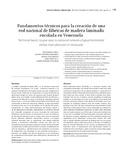Mostrar el registro sencillo del ítem
Fundamentos técnicos para la creación de una red nacional de fábricas de madera laminada encolada en Venezuela
| dc.rights.license | http://creativecommons.org/licenses/by-nc-sa/3.0/ve/ | |
| dc.contributor.author | Barrios, Eric | |
| dc.contributor.author | Contreras Miranda, Wilver | |
| dc.contributor.author | Sosa, Milena | |
| dc.contributor.author | Owen de Contreras, Mary E. | |
| dc.contributor.author | Rondón Sulbaran, Maria Teresa | |
| dc.date.accessioned | 2010-10-22T20:08:40Z | |
| dc.date.available | 2010-10-22T20:08:40Z | |
| dc.date.issued | 2010-06-30 | |
| dc.identifier.issn | 0556-6606 | |
| dc.identifier.uri | http://www.saber.ula.ve/handle/123456789/31649 | |
| dc.description.abstract | La Madera Laminada Encolada (MLE), es un elemento estructural de ventajas competitivas, con mayor resistencia respecto a un producto forestal hecho de madera maciza que esté cumpliendo la misma función, dado que su composición es a partir de láminas de dimensiones largas y/o cortas, de espesores que fluctúan desde el tablón hasta una chapilla, recomendablemente libre de defectos; y su proceso de fabricación, según su método de ensamblaje, permite formas rectas o curvas por medio del encolado de las láminas que conformarán el elemento estructural. Además, se logra racionalizar la materia prima por el uso de residuos de la industria del aserrío, consiguiendo un mejor aprovechamiento del bosque natural y de las plantaciones forestales, obteniéndose un producto forestal más sostenible comparado con otros materiales de construcción tradicional. A pesar de esto, en Venezuela no se hace uso intensivo de este tipo de elementos, por no contar, entre otros: con personal técnico calificado, adhesivos estructurales, normas y el parque industrial adecuado para su elaboración. Este trabajo pretende orientar a promotores industriales, siendo una guía con los fundamentos más importantes a tomar en cuenta a la hora de instalar una planta para la fabricación de la MLE en el país; considerando una serie de requisitos y especificaciones más resaltantes al momento de implementar esta tecnología; lo que permitiría promocionar y fomentar, con calidad, este tipo de productos en la manufactura de componentes estructurales para edificaciones, básicamente de interés social. | es_VE |
| dc.language.iso | es | es_VE |
| dc.publisher | SABER ULA | es_VE |
| dc.rights | info:eu-repo/semantics/openAccess | |
| dc.subject | Madera laminada encolada | es_VE |
| dc.subject | Producción | es_VE |
| dc.subject | Transferencia de tecnología | es_VE |
| dc.subject | Mercados | es_VE |
| dc.subject | Comercialización | es_VE |
| dc.title | Fundamentos técnicos para la creación de una red nacional de fábricas de madera laminada encolada en Venezuela | es_VE |
| dc.title.alternative | Technical basics to give raise to national network of glued laminated timber manufacturers in Venezuela | es_VE |
| dc.type | info:eu-repo/semantics/article | |
| dc.description.abstract1 | Glued laminated timber (GLULAM), is a structural member with competitive advantages over similar forest product made from solid wood due to properties such as: greater resistance -- given that it is composed of sheets of long and/or short dimensions with thicknesses that could vary from veneers (1-3mm thick) to planks (5cm thick), materials that are free of defects, and the possibility of producing straight or curved shapes by means of the gluing of the sheets that form the structural member. It also allows for the better use of raw materials by employing residues from the lumber industry, thus profiting more from the same natural forests and plantations while obtaining a forest product that is more sustainable as compared to other materials of traditional construction. In spite of this, Venezuela does not make extensive use of this type of structural members due to the lack of qualified technical personnel, structural adhesives, the absence of proper regulations and the industrial infrastructure appropriate for its elaboration, among other reasons. This work aims to guide industrial promoters by dealing with the most basic and important steps to take into account at the time of installing a plant for GLULAM fabrication in the country, considering the most important series of requirements and specifications needed to implement this technology in order to promote and develop quality structural members for of social interest housings. | es_VE |
| dc.description.colacion | 99-112 | es_VE |
| dc.description.email | ericjbarrios@yahoo.com | es_VE |
| dc.description.email | wilver_c@hotmail.com, wilconmi@doctor.upv.es; wilmercontrerasmiranda@yahoo.es | es_VE |
| dc.description.email | milenasosa@idec.arq.ucv.ve | es_VE |
| dc.description.email | marowde@doctor.upv.es, conowen@cantv.net | es_VE |
| dc.description.email | mariat@ula.ve | es_VE |
| dc.description.frecuencia | semestral | |
| dc.publisher.pais | Venezuela | es_VE |
| dc.subject.facultad | Facultad de Ciencias Forestales y Ambientales | es_VE |
| dc.subject.publicacionelectronica | Revista Forestal Venezolana | |
| dc.subject.seccion | Revista Forestal Venezolana: Notas Técnicas | es_VE |
| dc.subject.thematiccategory | Geografía | es_VE |
| dc.subject.thematiccategory | Medio Ambiente | es_VE |
| dc.subject.tipo | Revistas | es_VE |
| dc.type.media | Texto | es_VE |
Ficheros en el ítem
Este ítem aparece en la(s) siguiente(s) colección(ones)
-
Revista Forestal Venezolana - Número 054 - Vol 001
Enero - Junio 2010


